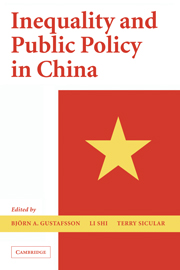Book contents
- Frontmatter
- Contents
- List of Tables and Figures
- Contributors
- Acknowledgments
- 1 Inequality and Public Policy in China: Issues and Trends
- 2 Income Inequality and Spatial Differences in China, 1988, 1995, and 2002
- 3 Growth and Distribution of Household Income in China between 1995 and 2002
- 4 Explaining Incomes and Inequality in China
- 5 The Distribution of Wealth in China
- 6 Growth, Inequality, and Poverty: A Comparative Study of China's Experience in the Periods before and after the Asian Crisis
- 7 What Has Economic Transition Meant for the Well-Being of the Elderly in China?
- 8 Inequity in Financing China's Health Care
- 9 China's Emerging Urban Wage Structure, 1995–2002
- 10 Unemployment, Earlier Retirement, and Changes in the Gender Income Gap in Urban China, 1995–2002
- 11 What Determines Living Arrangements of the Elderly in Urban China?
- 12 The Impact of Village-Specific Factors on Household Income in Rural China
- 13 The Redistributive Impact of Taxation in Rural China, 1995–2002: An Evaluation of Rural Taxation Reform at the Turn of the Century
- Appendix: The 1995 and 2002 Household Surveys: Sampling Methods and Data Description
- Index
- References
1 - Inequality and Public Policy in China: Issues and Trends
Published online by Cambridge University Press: 25 July 2009
- Frontmatter
- Contents
- List of Tables and Figures
- Contributors
- Acknowledgments
- 1 Inequality and Public Policy in China: Issues and Trends
- 2 Income Inequality and Spatial Differences in China, 1988, 1995, and 2002
- 3 Growth and Distribution of Household Income in China between 1995 and 2002
- 4 Explaining Incomes and Inequality in China
- 5 The Distribution of Wealth in China
- 6 Growth, Inequality, and Poverty: A Comparative Study of China's Experience in the Periods before and after the Asian Crisis
- 7 What Has Economic Transition Meant for the Well-Being of the Elderly in China?
- 8 Inequity in Financing China's Health Care
- 9 China's Emerging Urban Wage Structure, 1995–2002
- 10 Unemployment, Earlier Retirement, and Changes in the Gender Income Gap in Urban China, 1995–2002
- 11 What Determines Living Arrangements of the Elderly in Urban China?
- 12 The Impact of Village-Specific Factors on Household Income in Rural China
- 13 The Redistributive Impact of Taxation in Rural China, 1995–2002: An Evaluation of Rural Taxation Reform at the Turn of the Century
- Appendix: The 1995 and 2002 Household Surveys: Sampling Methods and Data Description
- Index
- References
Summary
Introduction
In recent decades China's economy has grown more rapidly and in a more sustained fashion than that of any other country worldwide. This growth has had many positive benefits, one of which is a substantial improvement in average standards of living. Most people in China have higher incomes, consume more and better goods, and live in better housing than ever before. Between 1988 and 2002, the time period covered in this volume, household income per capita on average nearly tripled in real terms (see Chapter 2). Also, life expectancy has increased, and education levels continue to rise.
With growth, however, has come a significant widening of income differences among households and individuals. Income inequality has risen from a relatively low level in the early 1980s to a level that is now considered high by international standards. Although increased inequality often goes hand in hand with economic growth and development, in China the speed with which the increase has occurred, and the level to which inequality has risen, is striking.
Inequality is not necessarily a problem. Most would agree that past policies in China had excessively compressed personal income differentials, so some increase was expected. Inequality reflecting differences in effort, experience, skills, investments, and risk can be justifiable from economic and social standpoints. Concerns arise, however, when incomes differ excessively in ways that reduce efficiency or violate accepted views of fairness and justice.
- Type
- Chapter
- Information
- Inequality and Public Policy in China , pp. 1 - 34Publisher: Cambridge University PressPrint publication year: 2008
References
- 6
- Cited by



